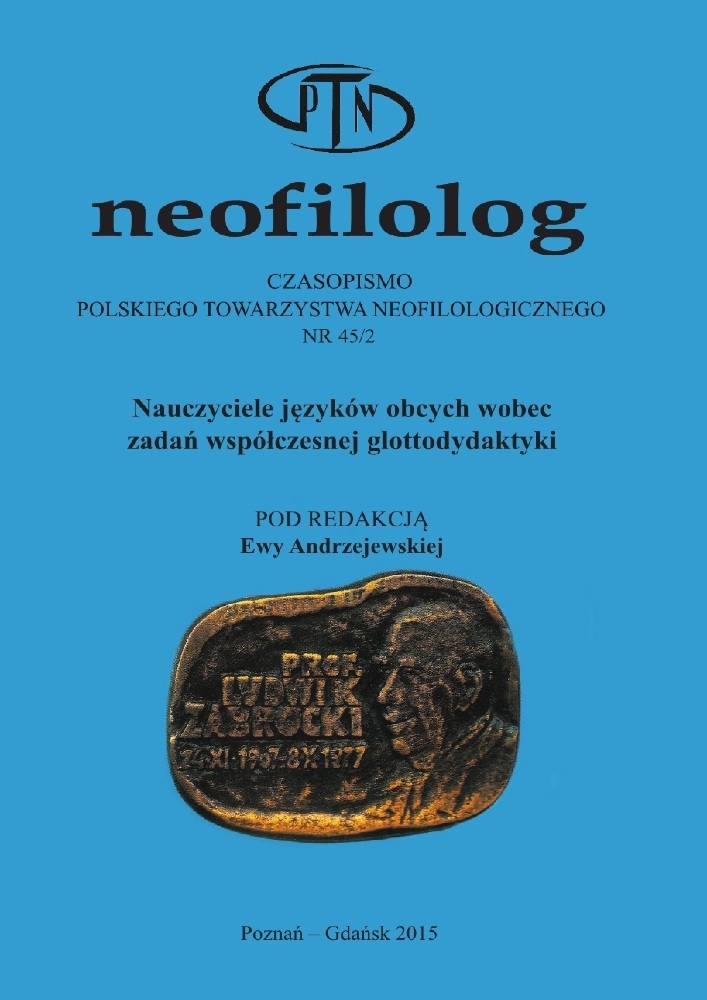Abstract
Adapting foreign language teaching to the requirements of studentswith special educational needs requires prior diagnosis of the developmental
potential of the pupils concerned. Because of the educational
and rehabilitative character of foreign language learning in students
with language and speech deficiencies, the diagnosis addresses the
possibilities of using foreign language learning in developing general
and linguistic competencies in both languages (native and foreign). The
article presents the aims of diagnosing linguistic communicative competencies
in the context of foreign language teaching. The differences
between speech diagnosis and diagnosis performed for the needs of foreign
language teaching are discussed, based on cases of pupils with deficiencies
in their native language (Polish). The evaluation of the students’
competencies involved reformulation as an instrument of linguistic diagnosis;
learning strategies were also considered in the assessment.
References
Béguin, Ch. 2008. « Les stratégies d’apprentissage : un cadre de référence simpli-fié ». Revue des sciences de l’éducation 34(1): 47-67.
Czaplewska, E., Milewski, S. (red.). 2012. Diagnoza logopedyczna. Podręcznik akademicki. Sopot: Gdańskie Wydawnictwo Psychologiczne.
Gunia, G. 2006. Terapia logopedyczna dzieci z zaburzeniami słuchu i mowy. Wybrane problemy teorii i praktyki surdologopedycznej. Kraków: Oficyna Wydawnicza Impuls.
Karpińska-Szaj, K. 2013. Nauczanie języków obcych uczniów z niepełnosprawnością
w szkołach ogólnodostępnych. Poznań: Wydawnictwo Naukowe UAM.
Karpińska-Szaj, K., Paprocka-Piotrowska, U. 2014. « La reformulation en tant que stratégie d’apprentissage d’une LE: vers son exploitation dans des situations non-ordinaires ». Roczniki Humanistyczne LXII/10 Glottodydaktyka: 55-82.
Krakowiak, K. 2006. „Pedagogiczna typologia uszkodzeń słuchu i osób nimi dotkniętych” (w) „Nie głos, ale słowo…”. Przekraczanie barier w wychowaniu osób z uszkodzeniami słuchu. (red. K. Krakowiak i A. Dziurda-Multan). Lublin: Wydawnictwo KUL: 255-288.
Martinot, C. 2012. « De la reformulation en langue naturelle, vers son exploitation pédagogique en langue étrangère: pour une optimisation des stratégies d’apprentissage » (w) Autour de la compétence d’apprentissage de langues: gestion des ressources métacognitives et cognitives. (red. K. Karpińska-Szaj, J. Zając). Synergies-Pologne 9: 63-76.
Martinot, C., Gerolimich, S., Bosniak-Botica, T., Tutunjiu, E. 2012. « Un phénomène complexe d’acquisition en langue maternelle: le cas des relatives dans une perspective translinguistique » (w) La complexité en langue et son acquisition (red. U. Paprocka-Piotrowska, C. Martinot, S. Gerolimich). Lublin: Towarzystwo Naukowe KUL: 169-212.
Podstawa Programowa z komentarzami. T. 3. 2009: Języki obce w szkole podstawo-wej, gimnazjum, liceum zasoby internetowe: http://www.lingwistyka.edu.pl /upload/materialy/167_podstawa_programowa_z_komentarzem_tom_3.pdf DW 20.08.2014.
License
Copyright (c) 2019 Neofilolog

This work is licensed under a Creative Commons Attribution-NoDerivatives 4.0 International License.
Authors
Authors of texts accepted for publication in Neofilolog are required to complete, sign and return to the Editorial team’s office the Agreement for granting a royalty-free license to works with a commitment to grant a CC sub-license.
Under the agreement, the authors of the texts published in Neofilolog grant Adam Mickiewicz University in Poznań a non-exclusive, royalty-free license and authorize the use of Attribution-NoDerivatives 4.0 International (CC BY-ND 4.0) Creative Commons sub-license.
The authors retain the right to the free disposal of the work.
Users
Interested Internet users are entitled to use works that have been published in Neofilolog since 2017, under the following conditions:
▪ attribution – obligation to provide, together with the distributed work, information about the authorship, title, source (link to the original work, DOI) and the license itself.
▪ no derivatives – the work must be preserved in its original form. Without the author's consent, it is not possible to distribute the modified work in the form of translations, publications, etc.
Copyrights are reserved for all texts published since 2017.
Miscellaneous
Adam Mickiewicz University in Poznań retains the property right as a whole (layout, graphic form, title, cover design, logo etc.).
